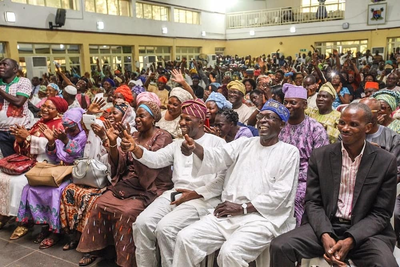The problem of migration and refugee crisis is as old as discussions on the violent acts that led to its existence. Several reasons can be provided as the cause of both legal and illegal migration, ranging from violence, war or search for better living conditions. With focus on illegal migration, international and national media has put out several information on the challenges encountered by the migrants and the receiving countries. Migration crisis in the international community is not an issue for a part of the country but as recent reports have been made, cuts across the international community as evenly as possible.
What is Migration?
According to International Organisation for Migration (IOM), migration is the movement of a person or a group of persons, either across an international border or within a state. It encompasses all kinds of movement and causes for the movement- refugees, displaced persons, economic migrants, family reunification, etc. Irregular migration, a more precise term for the purpose of this article, can be explained in two perspectives; the receiving or destination state and the sending state. For the destination state, irregular migration is the entry of a migrant into a country for work or stay without the authorized documents for immigration. For the sending state, it means that the individual haws not fulfilled the necessary requirement for leaving the country, i.e. absence of passport or travel documents. Though also referred to as illegal migration, it should not be mixed up with smuggling of persons or Human trafficking.
Migration crisis in Europe
In the beginning of 2015, Europe had a huge migration crisis when a huge number of people arrived in the European Union via the Mediterranean Sea or through Southeast Europe. Over a million migrants were reported to have come into the EU illegally and almost 400 persons died or went missing at sea. Most of these migrants have come from war torn or violent stricken countries.
Although a concrete solution to the problem of migration has not been provided, several attempts, both good and bad, have been made to contain the situation. The newest attempt is to help “would be” migrants before they set out for Europe. This, the EU plans to do by providing financial and technical aid for the states along the corridors.
The huge number of migrants coming into the EU has caused major political rifts within the region as some states have implemented more strict border control policies. This is despite the presence of the Dublin Regulation which was revised in 2013. The Dublin Regulation states that asylum seekers must remain in the first European country that they enter, as that country is responsible for their migrant asylum applications. European leaders have embarked on the mission to prevent a new upsurge of migrants arriving Europe from Africa and the Middle East. The migration crisis for Europe is the greatest challenge since the region’s debt crisis.
The United States and South America
The United States, under the administration of President Trump, has also introduced ways to control the influx of migrants from Mexico. This policy is very much different from past presidents’ policies on immigration. One of Trump’s important campaign promises was to build a wall around its borders. He also endorsed policies to limit legal migration. His administration has labelled immigrants as threats to the national and economic security of the country.
Though revised, Trump imposed a travel ban on 7 Muslim dominated countries. The United States has much less tolerance for illegal migrants. In 2007, the Immigration and Customs Enforcement (ICE) arrested about 111.000 illegal migrants in the US which was a 42% increase from the almost 78,000 arrested in 2016.
Increased flow of migrants across South America has been very challenging for the region especially Venezuela and Haiti. The collapse of the Venezuelan economy and political unrest in the country caused a huge number of migrants to leave the country, seeking for basic needs. And the, once, migrant receiving state became a sending state with its migrants in United states, Brazil, Columbia, Peru.
Africa is included
Another continent that has encountered migration problem is Africa. A lot of work has been done on the effect of migration on Europe and the United States, making them victims in this “ordeal”, but not so much on Africa. Africa, for a long time, has been seen as the continent that produces migrants, and this has contributed to the fear of Europe for the new flow in of migrants. However, there has been a dramatic reduction in the number of migrants from Africa and the Middle East into Europe since 2015.
New research has shown that the top ten countries with the most refugees are Asian and African countries. These countries are Jordan, Turkey, Pakistan, Lebanon, Iran, Ethiopia, Kenya, Uganda, The Democratic Republic of Congo and Chad. Hence, contrary to mainstream media, majority of African migrants do not leave the continent, they move to neighboring countries within the region. Between 2015 and 2017, the number of African migrants increased from 16 million to 19 million, that is , within the continent. Within the same period, the number of African migrants out of the continent moderately increased from 16 million to 17 million.
In June 2018, the United Nations Conference on Trade and Development (UNCTAD) released its Annual Economic Development in Africa report. A major point in this report was that majority of African migration is within Africa- to neighbouring countries. This point was re-emphasised on the African Development Bank’s Review. The largest migrant flow in central, east and west Africa were to neighbouring countries in their regions.
Uganda is one of the main hosts of African migrants with a huge population of South Sudanese migrants. The Ugandan government with assistance from the UNHCR provides migrants food and shelter. But with an increase in migrants, there has been a strain on this system.
Ethiopia, the second largest refugee host in Africa provides refuge for about 900,000 other Africans. As in Uganda, the funding request for refugees has not been met and this has put a strain on the Ethiopian government and locals.
What next?
Though there have been several policies to help with the migration crisis and some others in the works, a huge problem is how migrants will be dissuaded to remain in a country that seems harmful to their livelihood. It is important to know that though an unexpected migration issue can cause havoc to a state’s economy or security, migrants, depending on the skills they have, are complementary to workers in the labour force which will increase productivity. Nevertheless, immigration, especially into Europe has had significant influence on employment growth and the economy.
It could therefore be said that if better receptive policies are implemented in receiving states, the benefits of migration will be enjoyed by these states. On the other hand, if basic needs like security and employment are available in sending state, then these states will not loose its citizens, and in the end, its labour force to other countries.
Bibliography
African Development Bank – Building Today, a Better Africa Tomorrow. Accessed October 22, 2018. https://www.afdb.org/fileadmin/uploads/afdb/Documents/Development_Effectiveness_Review_2018/ADER_2018_Ch._5.pdf.
Gandhi, Dhruv. “Figures of the Week: Internal Migration in Africa.” Brookings. Last modified June 7, 2018. https://www.brookings.edu/blog/africa-in-focus/2018/06/07/figures-of-the-week-internal-migration-in-africa/.
“The International Migrant Stock: A Global View.” International Organization for Migration. Accessed October 22, 2018. https://www.iom.int/jahia/webdav/site/myjahiasite/shared/shared/mainsite/microsites/IDM/workshops/Data_Collection_08090903/conf_osaki.pdf.
McAuliffe, Marie, and Adrian Kitimbo. “African Migration: What the Numbers Really Tell Us.” World Economic Forum. Last modified June 2018. https://www.weforum.org/agenda/2018/06/heres-the-truth-about-african-migration/.


